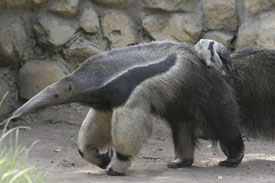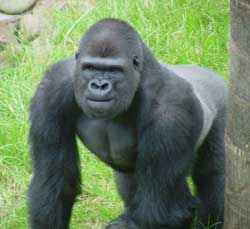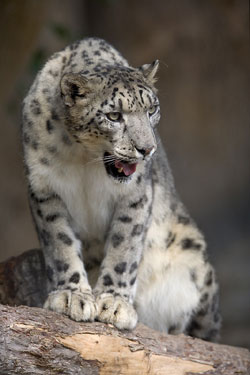Weird Zoology

We have some famous animals at the Santa Barbara Zoo – perhaps the best known might be Gemina, the crooked-necked giraffe. While she’s unusual within her own species, it’s sometimes easy to overlook the weirdness inherent in normal individuals happening to belong to a species that has adapted perfectly to its environment, food sources, and predators.
Giant anteaters, for example, are some of the strangest looking creatures in the world. Their long snouts, ungainly arms, and enormous fluffy tails give them a very unusual appearance – but each of these features has a use. The tail, draped over the anteater’s body, becomes an umbrella in inclement weather. Their snouts are ideal for poking into ant and termite nests, and a two-foot-long tongue, coated in sticky saliva to prevent bugs from escaping, only makes this adaptation more versatile. Anteaters’ arms are deceptively powerful, with long claws at the end which they use to rip apart rotten logs that might contain an insect nest.

These claws are what give the giant anteater its distinctive gait – these animals walk on their knuckles, folding the claws under so as to keep them out of the way. And they have one other nifty biological trick up their sleeves, one which any woman might envy – female anteaters can delay the implantation of embryos after they’ve already mated, allowing them to essentially choose when to be pregnant. Alan Varsik, Director of Animal Programs & Conservation at the zoo, said that this is a fairly recent discovery. Most animals have not yet been studied enough to understand all of their biological and behavioral quirks, and this is one which is still under investigation.
Of course, not all animals at the zoo are encouraged to breed. Varsik noted that “not breeding an animal is as important as breeding,” because the limited populations of certain species resident in zoos must be carefully managed to prevent inbreeding and genetic problems. The two Western lowland gorillas at the Santa Barbara Zoo, for example, are half brothers, both of whom have blood relatives at zoos nationwide. The one giant anteater in the zoo also has a number of descendants all over the world, including at zoos in London and Copenhagen.
This careful exchange, distribution, and breeding of zoo animals is arranged through the Association of Zoos & Aquariums, or the AZA. The AZA maintains a registry of animals’ relationships and a database of which individuals might make successful or unsuccessful breeding pairs. The snow leopards at the zoo, for example, are genetically a good match, according to the AZA. However, genetics aren’t everything, and some animals are behaviorally incompatible. The male snow leopard likes to be out during the day, while the female prefers to take the air at night – and as a result, they don’t spend enough time together to become a mated pair.
Since the Santa Barbara Zoo would like to breed the snow leopards, it’s possible that they will arrange a trade with another zoo, through the AZA, and find a female leopard who’s both genetically and behaviorally compatible with the male. This is only necessary, of course, when the zoo does want to breed a species. In other cases, a potential breeding pair may actually be prevented from mating using various forms of birth control. Mammalian species can be given birth control similar to the forms used by humans, either as an injection or with food. Veterinarians calculate dosages and oversee administration.

In the case of non-mammalian species, which have physiologies sufficiently different from that of humans to make our modified birth control methods ineffective, other methods are found. The zoo recently acquired an exhibit of Humboldt penguins, which will not breed when they’re given fake eggs to look after. The penguins will refrain from mating while they have the responsibility of dummy eggs.
Breeding and not breeding animals, exchanging individuals from one accredited zoo to another, and carefully selecting which animals will be happy and comfortable in exhibits with others is a complicated business – but it’s only a small part of what zoos are about. The Santa Barbara Zoo, along with many others, works hand in hand with conservation groups to raise awareness about endangered species, such as the California condor.
Look for more information on the Santa Barbara Zoo’s conservation efforts and strange fauna after the holidays, when this two-part series will conclude.



